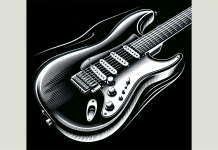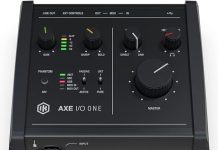This post may contain affiliate links. As an Amazon Associate, Guitar & Music Institute may earn commissions from qualifying purchases.
If You Want To Know How To Change A Guitar Pickup, Look No Further
Have you ever thought about how to change a guitar pickup or indeed any part of guitar DIY? If you have and not tried it yet, then this article will help put you right. We’ll also be running our eye over the tools needed to carry out guitar mod changes so watch out as we get this series underway.
It’s expensive to have repairs made on your guitar and there always, in most cases, a big lag time between putting your instrument in and actually getting it fixed. This article is all about how to change a guitar pickup, but it’s actually just the first in many guitar DIY articles that we’ll run. Making sure you have the right tools and know what you’re doing is a must. If you don’t, the instrument of your dreams could be lying in a heap on the workbench!
How To Install A Replacement Pickup
One of my favorite projects is pickup installation. There’s something very satisfying about taking a pile of wires, coils, and potentiometers and turning them into an awesome tone machine. Recently, I had the opportunity to install a set of vintage humbuckers designed by the late, great Seth Lover. His pickups are considered to be the Holy Grail of tone.
Out of thousands of pickups on the market, few can compare to those created by Seth Lover. Project Overview The guitar I was hired to retrofit was a reissue Fender ’72 Tele Thinline. My job was to remove the two ’72 reissue Wide Range humbuckers and replace them with two original Seth Lover Wide Range pickups that came from a ’72 Telecaster Deluxe the client owned in the mid-’70s. The guitar is long gone, but amazingly he’d held onto the pickups along with their harness. For almost 40 years, they’d been stored in a box and hauled back and forth across the country. The client didn’t even know if they still worked, but he wanted me to put them in his modern Thinline. The swap sounded simple enough, but every project has its challenges, and you never know what lurks beneath the control plate until you get in there. We’re about to find out what can—and did—happen.
The Original Wide Range vs. the Reissue
As I discovered, you can’t judge a pickup by its cover. The original and reissue pickups look nearly identical, but they couldn’t be more different. In lieu of a typical humbucker’s slugs and adjustable pole pieces, the original ’72 Wide Range (WR) pickup has “cunife” (copper/nickel/ ferrite) threaded rod magnets. Additionally, it has overwound coils (consisting of about 6,800 wraps of copper wire) and cranks out approximately 10.6k Ω of DC resistance. In other words, it’s a loud and bright powerhouse of a pickup. The ’72 reissue WR pickup has an alnico (aluminum/nickel/ cobalt) magnetized bar placed at the bottom of the pickup, non-magnetic slugs and pole pieces, and measures at about 8k Ω of DC resistance. It’s also potted—that is, sealed with wax to fill all the voids inside the coils. The reissue is basically a darker, modern humbucker in a vintage casing. Before installing any pickups—especially used or vintage units—use a multimeter to confirm they’re working and measure their DC resistance. This vintage WR bridge pickup has a DC resistance of 10.34k Ω. That‘s hot! Testing also revealed that the vintage neck WR humbucker was almost dead.
Test Before You Solder!
Before attacking the electronics with my soldering iron, I needed to test the pickups to know what I was working with. This is where things got interesting. I got out my multimeter to test the original pickups to make sure they were still functional. The WR neck pickup was practically dead—this made my heart sink! (My client wasn’t too happy either.) Fortunately, the vintage bridge pickup was perfect. At this point, we decided to leave the WR reissue pickup in the neck position and install the original ’72 pickup in the bridge position. Though we couldn’t use it for this project, the client will get the vintage WR neck pickup rewound by an expert.
Vintage and Modern Designs Collide
Of course, combining vintage and reissue WR pickups introduced a few new challenges.
The first question was, would we use the 1 Meg Ω pots from the original ’72 harness or go with the 250k Ω pots from the reissue Tele? The 250k pots produce a warmer tone; 1 Meg Ω pots make pickups sound much brighter. After some debate, we decided to use the 250k pots. Removing the vintage bridge WR pickup from its original 1 Meg Ω harness. The pickup will be connected to 250k Ω Tone and Volume pots in the reissue Thinline Tele. Unscrewing the reissue Tele’s pickguard. Always guide the screwdriver with your fingertips to prevent it from slipping off the screw and gouging the finish. I removed the reissue bridge pickup and prepared to install the original ’72 in its place.
The first problem I ran into was a huge glob of solder on the volume pot. In order to attach the ground and secondary lead wires from the pickup to the volume pot, this glob had to be removed. Before removing a pickup, mark where its lead wire attaches to the selector switch. This will tell you where to solder the replacement pickup’s lead. Opening the cover of the reissue Tele reveals the underside of the modern Fender humbuckers. Notice how the guitar is protected by a leather pad.
Things To Think About
To prevent the electronics from damaging the instrument, it’s important to rest them on some sturdy material—a small towel works in a pinch. To remove a pickup lead wire, touch the soldering tip to the connection, let the solder melt, and quickly pull out the wire. Be careful not to touch other wires with the iron and remove its tip immediately once the wire comes free. The risk in using a soldering iron for this task is you may overheat the pot and ruin it. To avoid that, I grabbed a small pair of flushcut dykes and gently crimped off the glob. With it removed, I was able to solder the ground and secondary lead wires without the risk of damaging the pot or having to use too much solder. Using too much solder can lead to a “cold weld” and create a poor connection for the wire.
After removing the wire, use the hot iron tip to clean off residual solder from the switch terminal. Using flush-cut dykes to remove a glob of solder before attaching the vintage WR pickup’s ground wire to the reissue Tele’s volume pot. Tinning the vintage WR’s ground wire. It’s easiest to do this before you mount a pickup into a pickguard or the guitar. The vintage WR humbucker (left) installed in the pickguard and now ready for wiring. Notice the difference between it and the modern counterpart with its exposed coil leads. Next, I soldered the primary lead from the vintage WR bridge pickup to the selector switch. “That should do it,” I thought, but I was too quick to judge.
Reassembly Of The Guitar
I reassembled the guitar, did a rough adjustment on the bridge pickup height, and then plugged in the guitar to test it. Attaching the lead wire from the vintage WR pickup. A pair of hemostats comes in handy for getting into tight places and clamping a wire to the terminal before you solder them together. The pickups sounded great in the neck and bridge positions, but not so good in the dual-pickup position. In fact, the combined pickups sounded like an amp with a blown speaker and no bass! Each pickup was wired correctly to the guitar, so what could cause this hideous tone? After mounting and soldering the replacement pickup, test your work before installing the pickguard on the guitar. Gently tap each pickup as you move through the switch selections to assure that everything is wired correctly, and roll your Volume and Tone pot back and forth to make sure they’re operating, too.
It turns out the pickups were out-of-phase with each other. This goes back to how differently these two pickups were designed and constructed. Remember, the reissue WR pickup is just a basic humbucker, whereas the original ’72 WR was a completely different animal. In the process of combining these humbuckers, we discovered they’re wired oppositely from each other. My solution was to reverse the start (primary lead) and the finish (secondary lead) of the reissue pickup. Once I swapped its leads around, the reissue pickup sounded great with its vintage forebear, and switched together they yielded a beautiful, bold chime. Don’t forget to connect the ground wire! This attaches internally to the bridge and strings. Rule of thumb: Do not mess with the wiring of a vintage pickup. New pickups are fair game, but the originals are sacred.
Fine-Tuning the Tone
Once we’d crossed that phase hurdle, I was almost finished with this crazy project. The last part of any pickup-replacement process is to adjust the height of the pickups to balance their individual output levels. Normally, when I adjust the height of the neck and bridge pickups, I set the bridge pickup a little closer to the strings than its sibling. If you don’t do this, the neck pickup can sound much louder than the bridge. However, because the vintage ’72 bridge unit is hotter than the reissue neck pickup, I knew I had to compensate for this.
The solution was to match the height on both pickups—an unusual but effective move. Once the guitar is strung up, it’s time to measure pickup height in order to balance the volume between the neck and bridge units. Fret the two E strings at the highest position, and then measure the gap between the bottom of each E string and the top of its pole piece. Incidentally, if you’re ever lucky enough to find an original WR humbucker, be very careful when adjusting its threaded magnets. The cunife material is very soft and can break easily. If the pole pieces are difficult to turn, stop.
The last thing you want to do is break one of these irreplaceable poles. Remember, these are magnets and without them, the pickup is useless. In fact, for this project I recommended that we not touch the vintage poles, and my client agreed to keep them at the height he’d set four decades ago.
read more at premierguitar.com
How To Change A Guitar Pickup Final Thoughts
Hopefully you enjoyed our first DIY article for guitar on how to change a guitar pickup. For more articles and the latest articles check out our homepage.
This post may contain affiliate links. As an Amazon Associate, Guitar & Music Institute may earn commissions from qualifying purchases.














